News Center: Short Takes Archive
Martin Blank died on June 13 at the age of 85.
A retired professor at Columbia University, Blank was a long-time EMF researcher, best known for his collaboration with Columbia’s Reba Goodman.
Writing in his 2014 book, Overpowered, Blank called himself an “unlikely activist” and urged people to practice precaution.
His obituary is posted on the Web site of the EMF Safety Alliance.
Notes from the NTP Press Conference
Here are four key takeaways from the NTP press conference held this afternoon, soon after the release of its two cell phone reports [these are no longer available]:
1. NTP’s bottom line on cell phone use: “This is not a high-risk situation.”
2. RF radiation has biological effects at levels previously believed to be innocuous —they may be good or bad.
3. NTP will continue to do RF health studies. A new exposure facility is being built on the NIEHS campus, which will be smaller and more flexible than the one used for the two-year exposures of the rats and mice in Chicago. It should be ready by late summer.
4. The finding that most impressed NTP was the increase of schwannoma of the heart in male rats. It was statistically significant. This was striking because of the similarity to acoustic neuroma, a tumor which has been reported in human studies. (For more on this, see our original story from May 2016.)
Of course, there is much else to delve into, notably the NTP analysis of DNA breaks, the incidence of brain tumors (glioma) among the male rats and the fact that they lived longer than the controls. The NTP attributes the significantly longer lifespan of the male rats to a lower incidence of chronic kidney disease (nephropathy). At the press conference, Dr. John Bucher, who led the project, suggested that the radiation might lessen inflamation which benefited the kidneys. (See also our previous coverage of DNA breaks in the NTP study.)
The NTP press release, “High Exposure to Radiofrequency Radiation Linked to Tumor Activity in Male Rats,” is here.
Even before the NTP released the two reports this afternoon, it posted an updated version of the “partial” report it issued on the rats in May 2016. The new report features a few tweaks and the addition of a new Appendix (B2), which responds to the criticism of NIH's Michael Lauer that have been frequently cited to counter concerns of a cell phone cancer risk.
After the release, Jeffrey Shuren, the director of the FDA’s Center for Devices and Radiological Health called the NTP evidence of a cancer risk “mostly equivocal or ambiguous.” The bottom line, he said, is that, “We believe the current safety limits for cell phones are acceptable for protecting the public health.” The FDA requested the NTP study back in 1999.
The NTP draft rat cell phone report runs 381 pages and the draft mouse report is 270 pages. They can both be downloaded here, where other related papers and data are also available. The NTP will hold a public peer review of the reports on March 26-28 in Research Triangle Park, NC.
An audio file of the press conference together with a transcript will be posted on the NTP Web site early next week, according to the NTP press office.
[February 6: The transcript and audio file are now available here.]
February 3
The headline in this morning’s New York Times story is “Rodent Studies Suggest Cellphones’ Risk to Humans in Minimal.” The title of the online version is “Cellphones Are Still Safe for Humans, Researchers Say.”
The Wall Street Journal took a different tack with “Why the Largest Study Ever on Cellphones and Cancer Won’t Settle the Debate.” The story included this useful graphic:
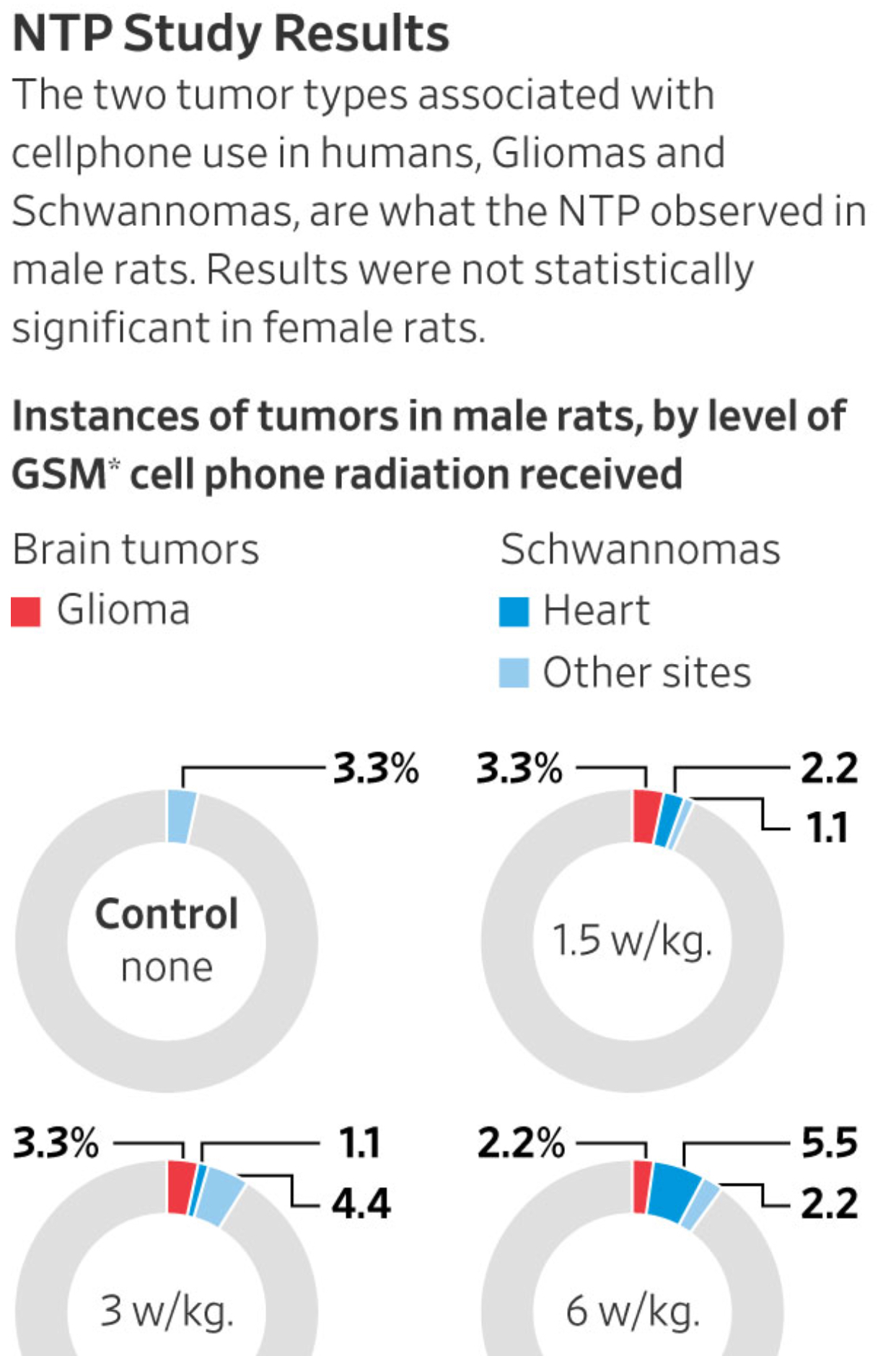
The Washington Post picked up the AP feed under “Cancer from Cellphones? New Studies Say No Need to Hang Up.” (Later in the day, it was changed to: “Studies Offer No Clear Answers on Safety of Cellphone Use.”) Meanwhile, the print editon ran a story by one of the paper’s staff reporters with the headline, “Human Health Conclusions Elusive After Cellphone Radiation Studies on Rodents.”
And Bloomberg ran with “Cell Phone Radiation Tied to Rare Tumor in Rats, Study Says.”
For more of Microwave News’ coverage of the NTP RF project, go here.
Peer Review Meeting March 26-28
The NTP has released two reports on the cancer risks from cell phone radiation (GSM and CDMA) on rats and mice. They are available here.
The NTP press release, “High Exposure to RF Radiation Linked to Tumor Activity in Male Rats” is here.
January 29, 12018
The National Toxicology Program (NTP) has announced that the draft reports on its $25 million animal study on the cancer risks associated with cell phone radiation will be released on February 2.
A peer review meeting is scheduled for March 26-28 in Research Triangle Park, NC.
Further details are available here. The Federal Register notice is here.
Preliminary results pointing to a cancer risk were published close to two years ago. See the Microwave News story that prompted the release here. For more of our detailed coverage, check out these links.
Highest SAR When Watch Is Held Next to the Head
Apple has released the RF exposure numbers —SARs, or specific absorption rates— for its new Series 3 Watches. These are the first wristwatches that can connect to cellular networks without being tethered to an iPhone.
The highest exposures, according to Apple, occur when the new watches are placed next to the head. The SAR measurements are based on a 10mm separation distance. The Model A1860 entails the highest exposure: 0.53 W/Kg averaged over 1g of tissue (0.52 W/Kg for the A1861).
The highest SAR on the wrist is 0.34 W/Kg for the A1861 (0.18 for the A1860). These SARs are measured without any separation from the wrist. Note that the SARs measured for the wrist are averaged over 10g of tissue.
The basic FCC SAR limit is pegged at 1.6 WKg averaged over 1g of tissue. Many European countries follow the ICNIRP guideline of 2.0 W/Kg averaged over 10g.
Averaging over the smaller volume (1g instead of 10g) can double or triple the maximum SAR (see MWN, J/A00, p.8, S/O01, p.10, and M/J03, p.4).
Here are the preamble and the SAR numbers that Apple posted on its Web site earlier today.
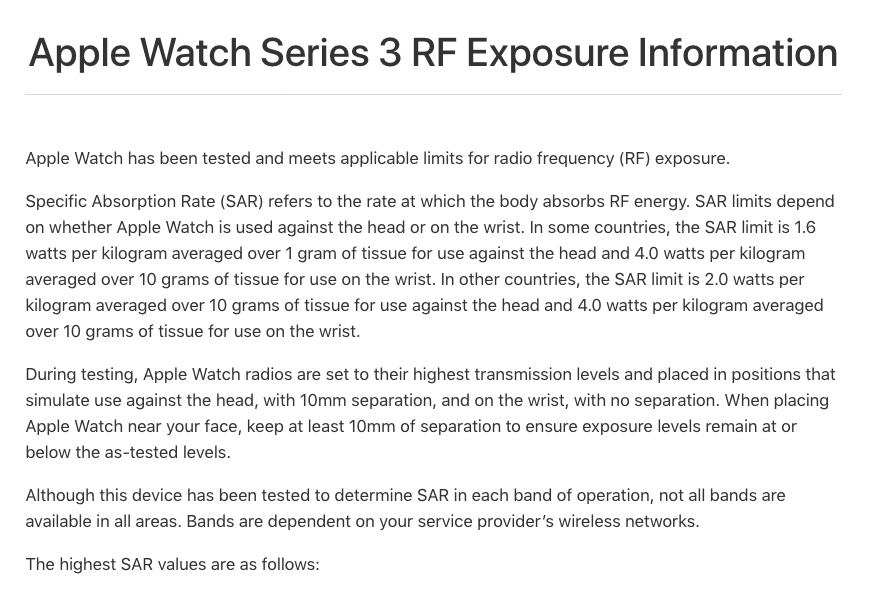
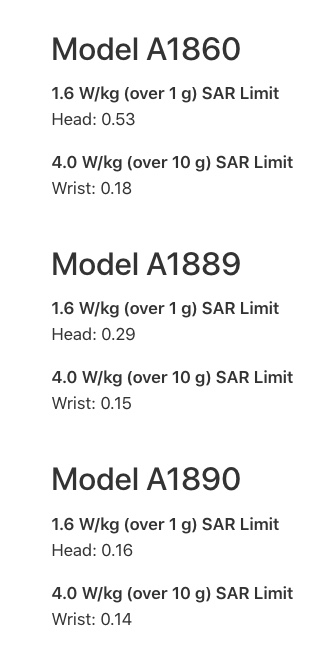
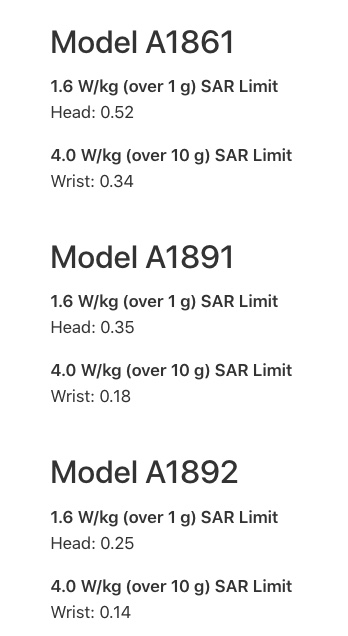

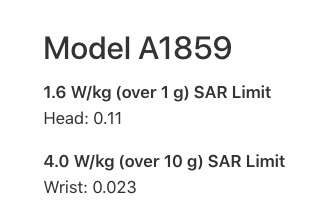
Apple has posted the SARs for its watches, phones and other products here.
The National Toxicology Program (NTP) will release the “complete results” of its $25 million project on cell phone cancer risks early next year, according to a statement posted on its Web site yesterday.
“The complete results from all the rats and mice studies will be available for peer review and public comment by early 2018,” the NTP states. The animals were exposed to GSM or CDMA radiation for two years before they were sacrificed and evaluated for signs of cancer.
The NTP report had been expected by the end of this year.
The final report has been highly anticipated since the spring of last year when the NTP announced that cell phone radiation increased the incidence of tumors in the brain and heart of male rats. At the time, the NTP posted some partial results from the rat experiments. No details of the mice studies have yet been made public. The early release followed a story on the findings in Microwave News.
NTP’s announcement of a cell phone–cancer risk attracted worldwide attention. The NTP results led the American Cancer Society and Consumer Reports, two organizations that had long been skeptical about a cancer link, to change their positions and advise caution in the use of wireless phones. Even so, many in the media, notably reporters at the New York Times and the Washington Post, expressed skepticism and told their readers to disregard the results. “Don’t Believe the Hype” ran the headline in the Washington Post. (See our “News Media Nix NTP Cancer Study.”)
The cell phone manufacturers —Apple, Google, Nokia (Microsoft) and Samsung— have all remained largely silent.
In addition to the animal studies, the NTP will release its findings showing DNA breaks in the brains of the male rats. The original plan was to publish those results as a stand-alone paper, but they will now be part of the general report.
One of the most commonly cited reasons to discount the NTP results has been that brain cancer rates have not been increasing in the general population. This may be true for all brain tumors combined, but it does not apply to the most virulent and deadly type, glioblastoma multiforme, better known as GBM. The incidence of GBM is rising in the U.S., as well as in other countries, including The Netherlands and the U.K. (Senator John McCain was recently diagnosed as having a GBM.)
GBM Going Up, Other Malignant Glioma Going Down
The incidence of glioblastoma multiforme (GBM), the most virulent and deadly type of brain cancer, is going up in the U.K., while the incidence there of other types of malignant brain tumors are declining, according to some newly published raw data.
Take a look at the two plots below and the trends are immediately apparent.
The incidence rates are not corrected for age, or any other factors. Better screening and diagnostics, the oft-cited explanations for an observed increase in a type of cancer, seems unlikely. Any such changes would probably affect all types of brain tumors. It is possible that the trends reflect the aging of the population, but that too seems doubtful since the likelihood of developing glioma increases with age once past the mid-teenage years.
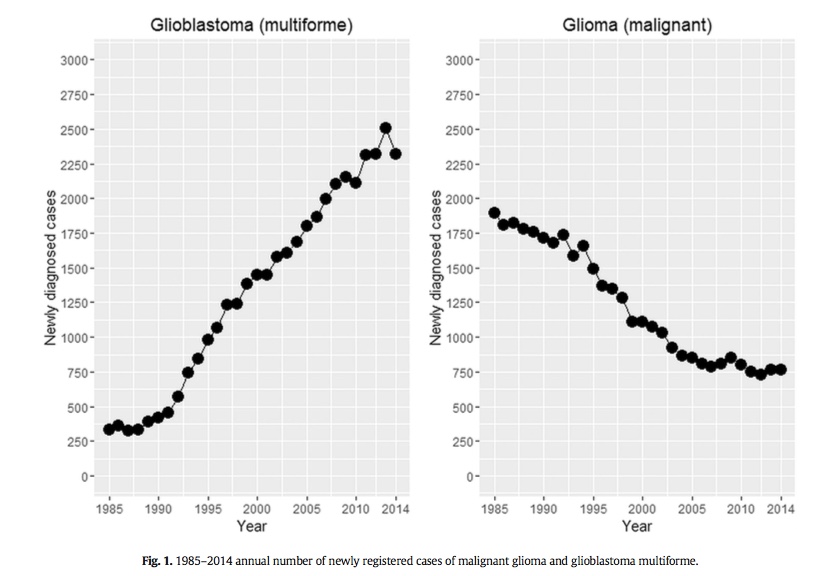
Source: Frank de Vocht, "Corrigendum," Environment International, posted January 25, 2017
(GBM is a type of glioma, so the right-hand plot would be better titled “Malignant Glioma other than GBM”)
The new data come from a correction to a paper published last year by Frank de Vocht, a lecturer at Bristol University. That paper, an analysis of the possible impact of the use of mobile phones on brain tumor rates in the U.K., was based, in part, on “incorrect data,” prompting de Vocht to issue the “Corrigendum” with these two plots of brain tumor incidences.¹
De Vocht states that the correction had “no significant impact” on his conclusions. Yet, the two plots in the correction look very different from those with the same titles in the original paper.
We asked de Vocht to comment on the significance of the side-by-side plots. He demurred. “I don’t know enough about how mixes of different types of brain cancer subtypes/gliomas behave over time,” he told us. de Vocht encouraged us to talk to Alasdair Philips, the founder of Powerwatch who has been studying brain tumor rates in the U.K. and is preparing his own analysis for publication. Indeed, it was Philips who first spotted the error in de Vocht’s paper, which led to the correction.
Here’s what Philips told us: “The simple take-home message of the two plots is that the number of the most aggressive type of brain tumors [GBM] is going up and the other types of lower-grade malignant glioma are going down. If better diagnosis were responsible for the changes in GBM, then you would expect the two trends to be going in the same direction.”
“As GBM is almost always quickly fatal it is unlikely that they were misdiagnosed in the past,” Philips added. “It looks like something is causing or at least stimulating agressive glioma growth. Clearly, it is no longer enough to look only at overall brain tumor rates.”
While the new plots in themselves say nothing about any possible links between cell phones and brain tumors, they go a long way toward puncturing the argument offered by numerous public health officials and media outlets that such an association is highly unlikely because the overall incidence of brain tumors has remained relatively stable over the last number of years.
The same argument has also been used to discount the results of the NTP study, which shows that cell phone radiation increased cancer among rats. (See, for instance, this video from the New York Times.)
GBM has been rising in the U.S. as well as in other countries.
1. Here is the de Vocht’s conclusion from his original paper:
“A causal factor, of which mobile phone use (and possibly other wireless equipment) is in agreement with the hypothesized temporal association, is related to an increased risk of developing malignant neoplasms in the temporal lobe.”
Historical Controls Show the Difference
One common criticism of the new NTP cell phone cancer study is that, unlike the male rats, there was no significant increase in tumors among female rats.
For instance in its latest assault on the NTP results, the New York Times is running a comment by a pediatrics professor in Indiana, in which he states:
“It’s also odd that increased cancer was seen only in male rats and not in female rats. Do we believe that females are protected from cell phone radiation?”
The answer is in the NTP report. The tables on pp.9-11 show a clear difference between male and female rats with respect to the incidence of spontaneous tumors among the NTP historical controls. Male rats were more than ten times more likely to develop malignant gliomas (brain tumors) than females: 11 of 550 males developed glioma, compared to only 1 of 540 females.
For malignant schwannoma of the heart, the difference is less pronounced, but still evident. Males were more than twice as likely to develop this type of cancer than the females: 9/699 vs 4/699.
Note also that, while none of the control rats in the NTP cell phone study had glial or Schwann cell tumors (or pre-cancerous lesions, hyperplasias, in these two cell types), some exposed females did develop them but the increases did not reach statistical significance.
This is what Ron Melnick, who ran the NTP study before he retired in 2009, had to say about the male vs females tumor counts:
“It is not surprising that the exposed males had more tumors than the females given what we have seen in the historical controls. But we can go one step further, the fact that we saw any of these tumors in the exposed females but none in the concurrent controls adds support to the conclusion that cell phone radiation leads to cancer among rats.”
__________________
See also:
News Media Nix NTP Phone Cancer Study; “Don’t Believe the Hype”
Are More People Getting Brain Tumors?
GBMs, the Most Virulent Type, Are Rising
And: “Gender Differences in Chemical Carcinognesis in National Toxicology Program 2-Year Bioassays,” published in Toxicologic Pathology in 2012. The paper is open access.
This evening, the National Toxicology Program (NTP) released a draft of the report on its two-year cell phone cancer study. Linda Birnbaum, the director of the NIEHS, and John Bucher, the leader of the study, will present the report at a teleconference tomorrow, Friday. They are the director and associate director of the NTP, respectively. [Birnbaum did not speak at the press conference. Bucher was accompanied by Michael Wyde, who ran the study, though he only made one comment during the hour-long telephone briefing.]
The report that was posted only covers rats. The accompanying study of mice found no effects on cancer.
For a copy of the report, go to bioRxiv.org. It includes the comments of some of those who were asked to review it.
The Microwave News story on what the NTP rat experiment shows is here.
Some early coverage on Friday morning in Wall Street Journal, Mother Jones, Scientific American and Consumer Reports.
The abstract of the report states:
"The US National Toxicology Program (NTP) has carried out extensive rodent toxicology and carcinogenesis studies of radiofrequency radiation (RFR) at frequencies and modulations used in the US telecommunications industry. This report presents partial findings from these studies. The occurrences of two tumor types in male Harlan Sprague Dawley rats exposed to RFR, malignant gliomas in the brain and schwannomas of the heart, were considered of particular interest, and are the subject of this report. The findings in this report were reviewed by expert peer reviewers selected by the NTP and National Institutes of Health (NIH). These reviews and responses to comments are included as appendices to this report, and revisions to the current document have incorporated and addressed these comments. Supplemental information in the form of 4 additional manuscripts has or will soon be submitted for publication. These manuscripts describe in detail the designs and performance of the RFR exposure system, the dosimetry of RFR exposures in rats and mice, the results to a series of pilot studies establishing the ability of the animals to thermoregulate during RFR exposures, and studies of DNA damage. Capstick et al., "A radiofrequency radiation reverberation chamber exposure system for rodents"; Yijian et al., "Life time dosimetric assessment for mice and rats exposed to cell phone radiation"; Wyde et al., Pilot studies of the National Toxicology Program's cell phone radiofrequency radiation reverberation chamber exposure system"; Smith-Roe et al, "Evaluation of the genotoxicity of cell phone radiofrequency radiation in male and female rats and mice following subchronic exposure."
Later:
The report and press briefing have led to a huge number of stories. Chek out Google news for many of these. Two of the best, not surprisingly, are in Science and Scientific American.
June 13, 2016
Michael Wyde presented the results of the NTP cellphone animal study at the BioEM2016 meeting in Ghent, Belgium, last week. A copy of his PowerPoint can be downloaded here.
Weak Magnetic Fields Can Promote Cancer
Weak RF fields may indeed be able to promote cancer, according to two leading members of the EMF/RF research community. Frank Barnes and Ben Greenebaum are offering theoretical arguments to explain how low-level RF radiation can alter the growth rates of cancer cells. They present their ideas in an article which has just appeared in the IEEE Power Electronics Magazine.
“Stuff is going on,” Barnes told Microwave News. “We can see changes with very small fields.” He granted that some may interpret what he is saying as “heresy.”
“What we are postulating does not violate any laws of physics and chemistry,” said Barnes, a distinguished professor emeritus of electrical engineering at the University of Colorado in Boulder and a long-time member of the National Academy of Engineering. Greenebaum, a professor emeritus of physics at University of Wisconsin-Parkside, was the editor-in-chief of BIoelectromagnetics from 1993 to 2006. Barnes and Greenebaum are coeditors of the most recent edition of the CRC Handbook of Biological Effects of Electromagnetic Fields.
“Bob Adair’s calculations are not wrong,” Barnes added. “They just don’t deal with the situations we are dealing with.” He was referring to Robert Adair, a professor emeritus of physics at Yale University, who has long maintained that weak field effects are incompatible with the laws of physics (more on Adair). Barnes was careful to point out that not all experiments would show effects because “biological systems have many feedback and repair mechanisms.”
“We have a reasonable hypothesis with a framework which allows others to do experiments which can show whether we are right or wrong,” Barnes said.
___________
For some papers by Barnes and Greenebaum on weak field effects, click here.
Based on More Than 500 Pages of Internal Documents
[Update: CDC E-Mails Made Public]
In August 2014, the Centers for Disease Control (CDC) issued and then rescinded precautionary advice on the use of cell phones. See our story, “CDC Calls for Caution on Cell Phones, Then Gets Cold Feet.”
Today,* Danny Hakim, an investigative reporter at the New York Times, has published a behind-the-scenes look at what was going on at the time, based on more than 500 pages of CDC internal documents, including e-mails, together with follow-up interviews. His story, “At CDC, a Debate Behind Recommendations on Cell Phone Risk,” states that Chris Portier —the official who originally endorsed precaution after he returned from the IARC meeting in 2011 where RF was classified as a possible cancer agent— was an isolated voice. “Mr. Portier’s view is not shared by many other experts,” according to Hakim.
He writes:
“CDC officials began debating how to back away from their recommendation of caution, internal emails show. One official proposed saying instead that other countries — ‘specifically the United Kingdom and Canadian governments’ — recommended caution. Others suggested pointing to determinations by agencies in Finland, Israel and Austria. Ultimately, though, no other country was mentioned.”
And concludes:
“‘Some organizations recommend caution in cellphone use,’ the agency’s guidelines now say. But the CDC is not one of them.”
Unfortunately, Hakim does not resolve the difference in outlook between CDC officials in the U.S. and their counterparts in many other countries. If, as Hakim argues, “Mainstream scientific consensus holds that there is little to no evidence that cell phone signals raise the risk of brain cancer or any other health problems,” why do the others —including those in France and Russia, which go unmentioned— recommend caution? Is the science interpreted differently in the U.S. than elsewhere, or is it really about politics and economics?
Other items are left hanging. For instance, he writes that internal e-mails reveal that a CDC draft was criticized by an outside expert for including “statements that are scientifically incorrect.” That expert appears to have been James Smith, a former chief of the CDC’s radiation branch, according to the Times. What is not clear is what the errors were.
Another loose end is a quote from an e-mail written by a CDC official in which she expresses “an incredible guilt complex” for her role in the precautionary guidelines published in June 2014. Her name is not given, nor is the reason for her guilt (because it was a false warning?).
Hakim quotes John Boice, the president of the National Council on Radiation Protection and Measurements (NCRP), stating that his own research has found “no evidence for associations with brain tumors or any other cancers.” What is left out is that Boice is a coauthor of the Danish cohort study, which many observers discount due to its many methodological shortcomings. (See our “The Danish Cohort Study: The Politics and Economics of Bias.”)
An internal CDC e-mail obtained by the Times shows that there was concern in Vermont over the state’s legal liability for allowing wireless technology in public schools and libraries.
The Environmental Health Trust has posted 518 pages of CDC e-mails —presumably the same documents released to the New York Times. See the EHT story here. The CDC e-mails are here. (The pdf is not searchable.)
January 13
Be sure to see our detailed story on what really happened at CDC, based on those internal e-mails.
____________________
* Hakim’s story appeared in the January 2 print edition under the headline, “At CDC, Evolution of Advice on Phones” on the front page of the business section.
